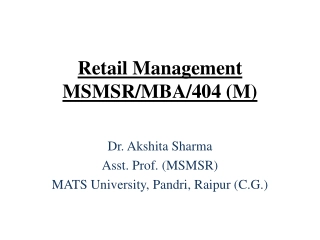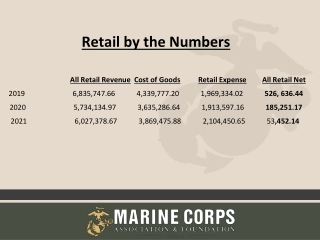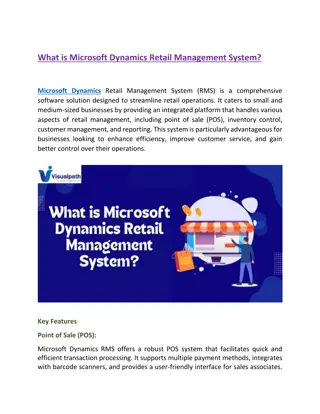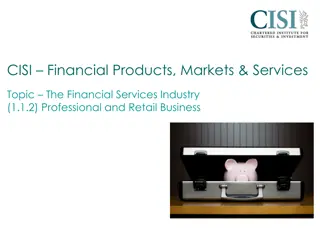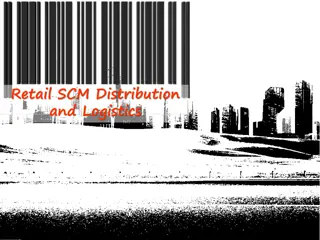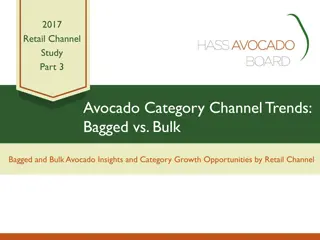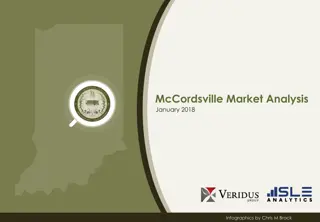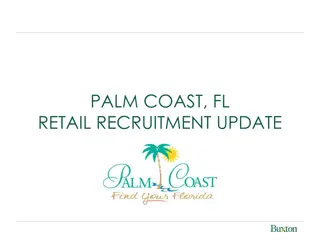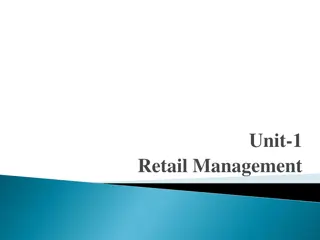Understanding Category Management in Retail: A Comprehensive Overview
Exploring the concept of category management through the story of Hazel's supermarket shopping experience at Super World. Learn about the importance of providing diverse product options to meet customer needs and the key components of effective category management strategies.
Download Presentation

Please find below an Image/Link to download the presentation.
The content on the website is provided AS IS for your information and personal use only. It may not be sold, licensed, or shared on other websites without obtaining consent from the author. Download presentation by click this link. If you encounter any issues during the download, it is possible that the publisher has removed the file from their server.
E N D
Presentation Transcript
Course Objectives Explain What is a Category Define Category Management Explain What is Category Management Describe the Basic Principles of Category Management Explain the Components of Category Management Explain the Steps of Category Management Business Process Describe the Components of Category Role Describe the Components of Category Strategy Explain the Various Sub-category Strategies Explain the Steps for Category Tactics and Execution Describe How to Successfully Implement Category Strategy Explain What is a Tactogram Explain What are Category Captains List the Benefits of a Category Manager Describe the Important Meetings of Category Management
Introduction Daily Needs Hazel Smith is a housewife and regularly visits her local supermarket, Daily Needs to shop for groceries, vegetables and fruits.
Introduction However, lately she has been greatly disappointed by the lack of options in some of her key needed products such as Cooking Oil, Shampoo, and Coffee etc.
Introduction Hazel has been thinking of going to another supermarket where she would be able to get more options of choosing various products such as of national or local brands, private label products of economy, value or premium quality or fresh or canned products.
Introduction Super World Her neighbor, Janet suggests another newly opened supermarket Super World that is close by in their neighborhood.
Introduction Super World Hazel decides to give Super World , the new supermarket a try. Hazel visits Super World for her next grocery shopping.
Introduction Hazel is delighted to find that Super World stocks a wide variety of options for each product category such as food items, coffee, tea, shampoo, shaving creams, apparels, fruits, vegetables, cooking oil, cheese, butter etc.
Introduction Super World Hazel is very happy with her shopping experience at Super World . She is not only able to find all the brands that she regularly uses but also ends up buying a few other new private label and branded products.
Introduction Yes, the key difference between Daily Needs and Super World is that though both of them are supermarkets, Super World makes a good and strong effort to cater to the needs of its customers.
Introduction Super World has an effective category management strategy that helps to satisfy and please its customers.
Introduction Daily Needs On the other hand, Daily Needs does not cater to the needs of its customers. It buys products and brands based on the retailer bias rather than based on customer needs and opinions.
Introduction Category Management is a process of maximizing sales and profits while enhancing product value and customer experience. Thus, Category Management is crucial for any retailer s success.
What is Category Management? So, Category Management is a process of maximizing sales and profits while enhancing product value and customer experience. The main aim of category management is to gain a better understanding of consumer needs which would ultimately form the basis for retailers & suppliers strategies, goal and work processes.
Category Management Framework The image given below shows the overview of the category management framework. Category Tactics and Execution Market Insight Company Goals Category Strategy Follow-up Target Customer Category Definitions Consumers Tactogram KPI Category Role Assignments Dashboard Trends Strategy Category Management Analytical Tools Financial Goals Category Strategy Assignments Economy Format Strategies Competitors Tactogram Definitions Corrective Actions Fact-based Actions Category Department Strategy Suppliers Category Plans
Step 1: Category Definition Step 1: Category Definition Step 1: Category Definition: In this step, the retailer defines the Category, that is, what products are to be included/excluded etc. So, the retailer has to identify a distinct, manageable group of products/services that consumers perceive to be interrelated/substitutable in order to meet consumer needs.
Step 4: Category Scorecard Step 4: Category Scorecard Step 4: Category Scorecard: In this step, the retailer sets objectives and targets for the category.
Components of Category Role The following are the various components of Category Role : Destination Preferred/Routine Occasional/Seasonal Convenience Let us look at each in detail.
Sub-category Strategies The table given below shows some of the sub-category strategies: Sub-category Strategies Category Strategy Objectives This strategy is used to bring the consumer into the store, purchase from the category and from the store in general. This strategy is used to increase the consumer s average purchase of the category. This strategy is used to increase the sales of high margin products. This strategy is used to protect the current market share of the store and protect the turnover of sub-categories against competition. This strategy is used to meet the consumer s needs by offering trendy and innovative products. This strategy is used to create an image of the store in the minds of the target consumer, in any of the domains such as: pricing, service, quality or assortment. Category Strategies Traffic building Transaction building Profit generating Share protecting Excitement creating Image enhancing
Steps for Category Tactics and Execution The following are the steps to be followed in category tactics and execution: Do a rigorous follow up, review and ongoing improvement. S tep S tep - - 4 4 Execute the plan. S tep S tep - - 3 3 Based on the strategic category plan which results in the tactogram and the market understanding resulting from step 1, you should prepare an action plan for the category. Prepare a complete internal and external overview of the market environment such as identifying the trends, competitors, company s market share, sales development, margin development, assortment width and depth, price comparisons, and so on. S tep S tep - - 2 2 S tep S tep - - 11
Tactogram A Tactogram is a handy tool that helps to put into practice the various concepts of category management. There are various versions of tactogram used by different organizations. However, the best version is one which combines both roles and strategies.
ManagementStudyGuide.com This is a DEMO Course On Category Management. Join MSG Today and Get Access to Unlimited Courses. What You Get: 1. View All Courses Online. 2. Download Powerpoint Presentation for Each Course. 3. Do the Knowledge Checks for Each Course.


